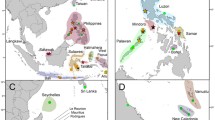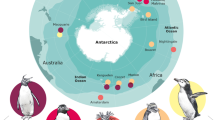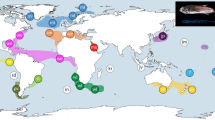Abstract
We present a phylogeographic analysis of an abundant New Zealand endemic sea-star, Patiriella regularis, to help pinpoint the location of an important biogeographic disjunction in central New Zealand. The analysis incorporates 284 mtDNA control region sequences (approximately 800 bp) of P. regularis from 22 coastal locations around New Zealand. We detected 132 haplotypes, with a mean divergence of 0.96%. AMOVA analysis of New Zealand samples is consistent with a north-south biogeographic disjunction across central New Zealand (among-group genetic variance=6.10%; P=0.0005). Cook Strait, the shallow marine strait separating the main islands, is not correlated with the disjunction: samples from northern South Island are genetically indistinguishable from North Island samples (variance=1.69%; P=0.073). These results are consistent with the hypothesis that upwelling zones south of Cook Strait constitute a significant barrier to larval dispersal.



Similar content being viewed by others
References
Apte S, Gardner JPA (2002) Population genetic subdivision in the New Zealand greenshell mussel (Perna canaliculus) inferred from single-strand conformation polymorphism analysis of mitochondrial DNA. Mol Ecol 11:1617–1628
Asakawa S, Himeno H, Miura K–I, Watanabe K (1995) Nucleotide sequence and gene organization of the starfish Asterina pectinifera mitochondrial genome. Genetics 140:1047–1060
Avise JC (2000) Phylogeography. The history and formation of species. Harvard University Press, Cambridge Mass.
Barnes EJ (1985) Eastern Cook Strait region circulation inferred from satellite-derived, sea-surface, temperature data. N Z J Mar Freshw Res 19:405–411
Bennett E (1927) Notes on some New Zealand seastars and on autonomous reproduction. Rec Cant Mus 3:125–149
Bowen BW, Bass AL, Rocha LA, Grant WS, Robertson DR (2001) Phylogeography of the trumpetfishes (Aulostomus): Ring species complex on a global scale. Evolution 55:1029–1039
Bowman MJ, Kibblewhite AC, Murtagh RA, Chiswell SM, Sanderson BG (1983) Circulation and mixing in greater Cook Strait, New Zealand. Oceanolog Act 6:383–391
Byrne M, Barker MF (1991) Embryogenesis and larval development of the asteroid Patiriella regularis viewed by light and scanning microscopy. Biol Bull 180:332–345
Clarke KR, Gorley RN (2001) PRIMER v5: user manual/tutorial. PRIMER-E, Plymouth, U. K.
Evans BS, White RWG, Ward RD (1998) Genetic identification of asteroid larvae from Tasmania, Australia, by PCR-RFLP. Mol Ecol 7:1077–1082
Excoffier L, Smouse PE, Quattro JM (1992) Analysis of molecular variance inferred from metric distances among DNA haplotypes: application to human mitochondrial DNA restriction data. Genetics 131:479–491
Francis MP (1996) Geographic distribution of marine reef fishes in the New Zealand region. N Z J Mar Freshw Res 30:35–55
Gardner D (1954) Sea surface temperature in the South West Pacific Ocean from 1949 to 1952. N Z J Sci Tech Ser B 36:285–303
Harris TFW (1990) Greater Cook Strait: form and flow. Gordon DP (ed) DSIR Marine and Freshwater, Wellington, New Zealand, pp 1–212
Hart MW, Byrne M, Smith MJ (1997) Molecular phylogenetic analysis of life-history evolution in asterinid starfish. Evolution 51:1848–1861
Heath RA (1985) A review of the physical oceanography of the seas around New Zealand. N Z J Mar Freshw Res 19:79–124
Huelsenbeck JP, Ronquist F (2001) MRBAYES: Bayesian inference of phylogeny. Bioinformatics 17:754–755
Lessios HA, Kessing BD, Pearse JS (2001) Population structure and speciation in tropical seas: global phylogeography of the sea urchin Diadema. Evolution 55:955–975
Menge BA, Lubchenco J, Bracken MES, Chan F, Foley MM, Freidenburg TL, Gaines SD, Hudson G, Krenz C, Leslie H, Menge DNL, Russell R, Webster MS (2003) Coastal oceanography sets the pace of rocky intertidal community dynamics. Proc Natl Acad Sci USA 100:12229–12234
Nelson WA (1994) Distribution of macroalgae in New Zealand—an archipelago in space and time. Bot Mar 37:221–223
Pawson DL (1961) Distribution patterns of New Zealand echinoderms. Tuatara 9:9–23
Pawson DL (1965) The distribution of echinoderms along the East coast of New Zealand. Trans R Soc N Z 6:245–252
Perrin C, Wing SR, Roy MS (2004) Effects of the hydrographic barriers on population genetic structure of the sea star Coscinasterias muricata (Echinodermata, Asteroidea) in the New Zealand fiords. Mol Ecol 13:2183–2195
Posada D, Crandall KA (1998) MODELTEST: Testing the model of DNA substitution. Bioinformatics 14:817–818
Rhodes LL, MacKenzie AL, White DA, Smith PJ (1994) Movement of mussel spat within New Zealand: the risks of associated toxic microalgal introductions. Cawthron Institute Report 473, New Zealand
Rice WR (1989) Analyzing tables of statistical tests. Evolution 43:223–235.
Roy MS, Sponer R (2002) Evidence of a human-mediated invasion of the tropical western Atlantic by the ‘world’s most common brittlestar’. Proc R Soc Lond B 269:1017–1023
Schneider S, Roessli D, and Excoffier L (2000) ARLEQUIN, Version 2.000. A software for population genetic analysis. Genetics and Biometry Laboratory, University of Geneva, Switzerland
Sponer R (2002) Phylogeography and evolutionary history of the cosmopolitan brooding brittle star Amphipholis squamata (Delle Chiaje, 1828; Echinodermata: Ophiuroidea). PhD Thesis, Department of Zoology, University of Otago, New Zealand
Stanton BR (1976) Circulation and hydrology off the west coast of the South Island, New Zealand. N Z J Mar Freshw Res 10:445–467
Stanton BR, Moore MI (1992) Hydrographic observations during the Tasman Boundary Experiment off the west coast of the South Island, New Zealand. N Z J Mar Freshw Res 26:339–358
Star B, Apte S, Gardner JPA (2003) Genetic structuring among populations of the greenshell mussel Perna canaliculus revealed by analysis of randomly amplified polymorphic DNA. Mar Ecol Prog Ser 249:171–182
Swofford DL (1998) Phylogenetic analysis using parsimony (and other methods) PAUP*4.0b10. Sinauer, Sunderland, Mass.
Tamura K, Nei M (1993) Estimation of the number of nucleotide substitutions in the control region of mitochondrial DNA in humans and chimpanzees. Mol Biol Evol 10:512–526
Walsh PS, Metzger DA, Higuchi R (1991) Chelex 100 as a medium for simple extraction of DNA for PCR-based typing from forensic material. Biotechniques 10:506–513
Waters JM, Roy MS (2004) Phylogeography of a high-dispersal New Zealand sea-star: does upwelling block gene-flow? Mol Ecol 13:2797–2806
Acknowledgements
Smita Apte provided useful discussions on New Zealand’s marine biogeography. The manuscript was improved by comments from Mike Johnson and two anonymous reviewers. Funding for the study was provided by contract no. UOO-914 from the Marsden Fund administered by the Royal Society of New Zealand.
Author information
Authors and Affiliations
Corresponding author
Additional information
Communicated by M.S. Johnson, Crawley
Rights and permissions
About this article
Cite this article
Ayers, K.L., Waters, J.M. Marine biogeographic disjunction in central New Zealand. Marine Biology 147, 1045–1052 (2005). https://doi.org/10.1007/s00227-005-1632-7
Received:
Accepted:
Published:
Issue Date:
DOI: https://doi.org/10.1007/s00227-005-1632-7




